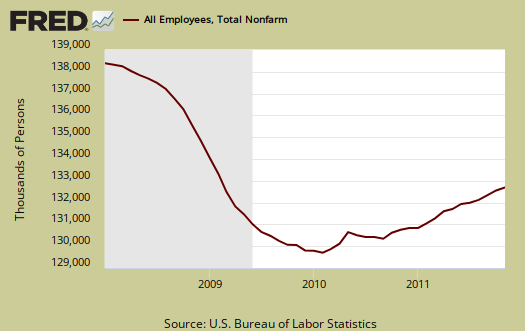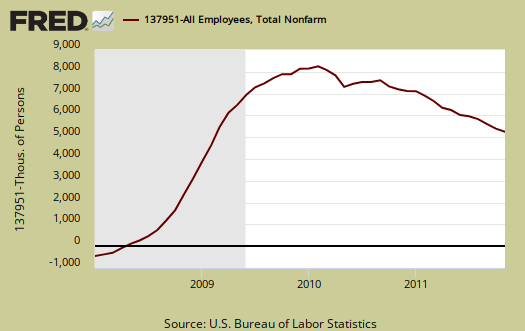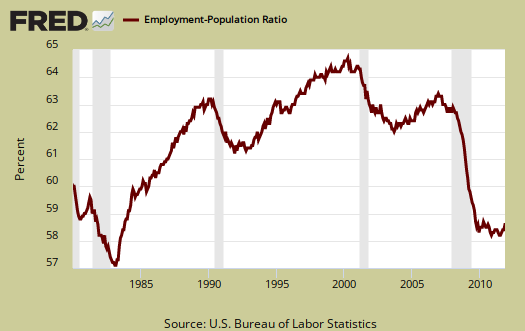The November 2011 monthly unemployment figures show the official unemployment rate dropped -0.4 percentage points to 8.6% and the total jobs gained were 120,000. Total private jobs came in at 140,000. Government jobs dropped -20,000. 22,300 of those jobs added were temporary.

The BLS has some big payroll revisions for September and October which are a large improvement from the originally reported numbers.
The change in total nonfarm payroll employment for September was revised from +158,000 to +210,000, and the change for October was revised from +80,000 to +100,000.
Below is the nonfarm payroll, the total number of jobs, seasonally adjusted. Since the start of the great recession, declared by the NBER to be December 2007, the United States has officially lost 6.275 million payroll jobs. That does not take into account additional jobs needed to employ the United States increased population, but does include the jobs added over the over the almost four years, or 47 month time period.

Below is a running tally of how many official jobs permanently lost since the official start of this past recession. This is a horrific tally and notice this isn't taking into account increased population growth, which implies the United States needs to create at least 10.2 million jobs or self-employment. This estimate assume a 62.7% civilian non-institutional population to employment ratio, as it was in December 2007, which implies an additional 3.9 million jobs needed over a 47 month time period beyond the ones already lost.

If one takes the current civilian non-institutional population and the December 2007 to employment ratio and then subtracts off the current number of payroll jobs, the number of jobs to get to pre-recession levels is much worse, 19.05 million jobs. This 19 million jobs needed number doesn't take into account population subset fluctuations, for example, those retired percentages increasing. It also isn't taking into account agriculture workers and self-employed, currently at 2.254 million and 8.631 million, respectfully. Reported Payrolls only counts nonfarm jobs, no matter how many hours of work they actually are. Many people work 2 to 3 jobs to get by. 8.518 million of the 26.874 million part-timers working low hours are doing so because they cannot get full time jobs.
The increasingly low labor participation rate is now at 64.0%, a minus two point drop from October. If we go back to December 2007, the labor participation rate was 66%. The highest civilian labor participation rate was in January 2000, at 67.3%. What this means is there are over 4.8 million people not be accounted for in the official unemployment rate, in other words counted as employed or unemployed, who probably need a job and can't find one. That's in addition to the official 13.303 million unemployed.

The employment to population ratio is now 58.5%, an uptick of 0.1 percentage point, but still at record lows. You have to go back to the severe recession of 1983, October to find such low ratios. The uber-low ratios are not a structural change, such as all families decided to have a stay at home caretaker, or magically a host of people could retire early. The low employment to population ratio are people dropping out of the labor count.
These numbers are important because unemployment is a ratio, percentage or during a limited time period, the number of people actively looking for a job and counted. Many people are not counted in the official unemployment statistics, yet when looking behind the official numbers it's clear America has more potential workers and less jobs in so called recovery than during one of the worst post WWII recessions.

One needs at least 90,000 and some estimate up to 225,000 permanent full time jobs, added each month just to keep pace with U.S. civilian workforce population growth. That's not general population, that's the group needing a job.
January 2012 will finally incorporate the 2010 Census numbers for increased population in the BLS Household survey. Not only will this affect labor participation and employment to population ratios, but it will also give a improved non-institutional civilian population estimate, upon which calculations to figure out how many jobs are needed each month for population growth, are based.
This unemployment report is statistically misleading due to the ratios that lowered the official unemployment rate. 120,000 payroll jobs are not great. Odds are we will see large adjustments next month in population and not in the labor force numbers when the annual adjustments are added to the December data. This truly throws the monthly numbers off and one cannot compare month to month at all.
The BLS Commisioner's Statement claims there has been an average of 131,000 payroll jobs each month. That's true, but if one takes the previous 6 months, the average is 90,300 payroll jobs per month.
The United States has jobs crisis going on for over 47 months! Watch out for pundits trying to claim this is a good report, it's not, it's mediocre. Payrolls are the number to watch. The unemployment rate is simply a ratio, based on population numbers.
Here is last month's unemployment report overview, unrevised.

Recent comments